Driving Success with More Sustainable Advertising Practices
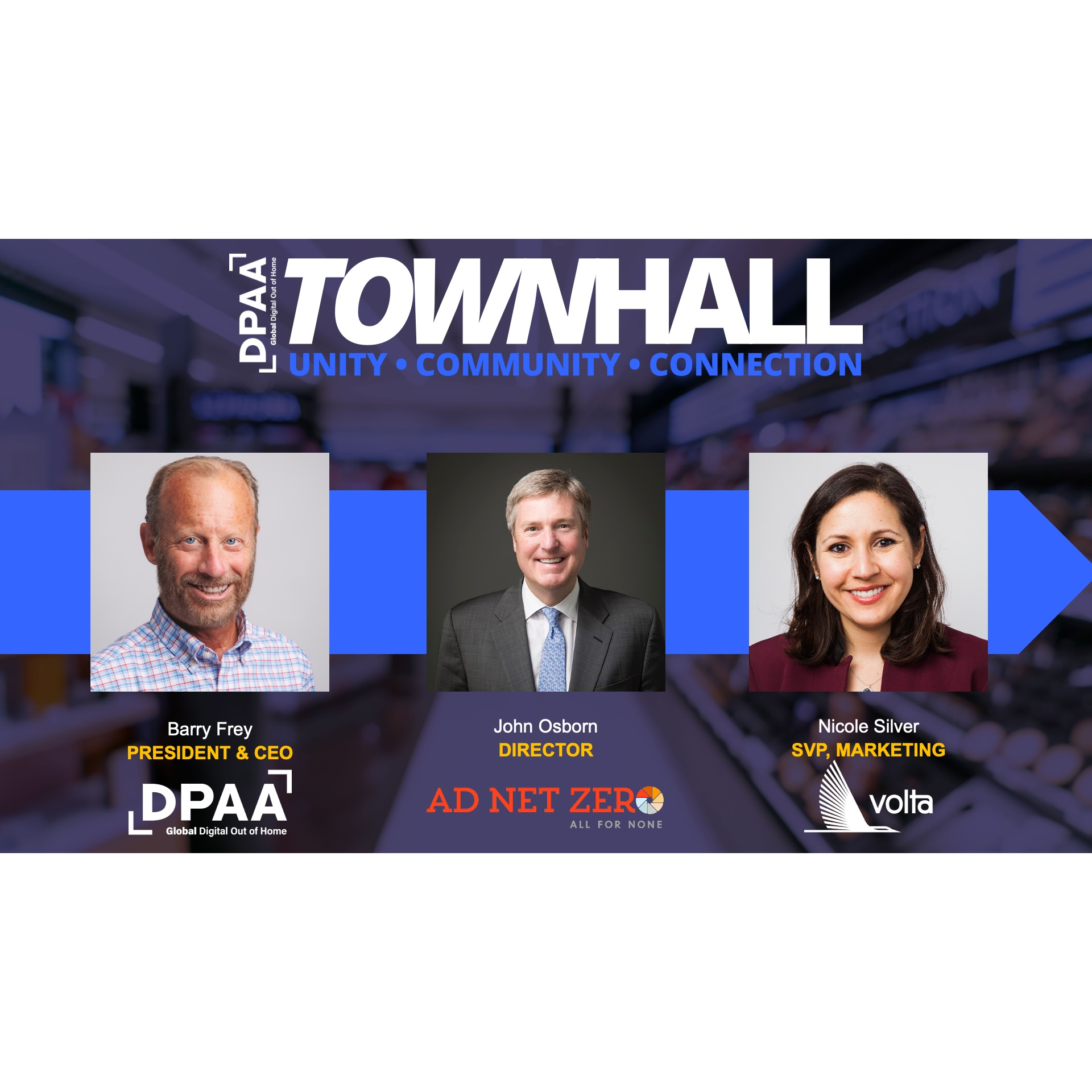
At the March global streaming meeting of the Digital Out of Home (DOOH) trade association, DPAA CEO Barry Frey delivered on the membership promise of industry education via three compelling conversations. There to discuss the imperative of sustainability in advertising were speakers from Ad Net Zero and Volta. That was followed by a discussion with the new global president of GroupM's appropriately named Business Intelligence division, who provided insights on advertising trends and future projections.
In the kick-off conversation, well-timed leading into Earth Month, Frey (re)introduced John Osborn, who many on the call knew from his previous roles as CEO of OMD and BBDO, previous key note at the DPAA Summit and now director of Ad Net Zero, which the DPAA now proudly supports. When one trade association becomes a member of another association, it must be for a good reason. In the case of DPAA and others, from the 4A's to the ANA, one very good reason for joining is, frankly, to benefit the planet.
A Global Commitment to Net Zero
The U.K.-based pro-social organization has been expanding with DPAA's partnership and others to show advertisers how to reduce their impact on the earth. Ad campaigns can have a significant carbon footprint and we can all now work towards ameliorating excess.
The advertising industry has traditionally not been seen as a significant contributor to environmental pollution. And yet, its impact has risen steadily, with the programmatic ecosystem using a surprising amount of computing power. Simple abatement efforts include opting for a phone call instead of a full business travel, reducing digital file sizes, optimizing ad versions to reduce file redundancies, and aiming for local storage over cloud storage.
As the world becomes more conscious of the immediate need for action, industries of all kinds are stepping up to do their part in reducing their carbon footprint. And the data has borne out the value of companies' efforts in appealing to environmentally conscious consumers who are "voting with their purses." But more importantly, Osborn noted, "It's incumbent on all of us to figure out how we can transparently share best practices and begin to create movement ... It's critical that we do it now because if we wait much longer, we're at the point of no return."
"Barry [Frey]" he said, acknowledging the DPAA participation, "I want to just thank you and your membership and your team for your support. Because, as it relates to Ad Net Zero, no matter which seat you're sitting in, it's pretty hard to debate the importance of a cleaner, better planet in the long term." (A sobering U.N. report on the earth hitting a critical warming threshold by the early 2030s was reported in the New York Times that same week, noting that even holding at current levels "will require global cooperation, billions of dollars and big changes.")
From Awareness to Action Plan: Five Steps to Sustainable Advertising
Osborn toplined Ad Net Zero's detailed five-part Action Plan for the ad industry, which starts with "getting your house in order" -- a commitment by agencies and marketing services companies to reduce their operational carbon emissions by first identifying their carbon footprint data; then, reducing emissions by switching to renewable energy, for example; to agreeing to "Change the Brief," an initiative that provides advertisers with more sustainable solutions to their campaign briefs, and also help change consumer behavior through messaging.
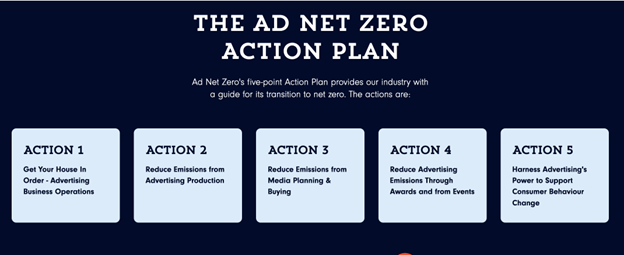
Osborn sparked pride on the call, reminding DPAA Global members that, "In times of turmoil or a crisis, when advertising comes together it can do amazing things, whether it's restoring spirits after a wartime or a disaster, or dare I say even the Great Recession. Advertising has the power to not only build brands and build businesses but can build countries and can build movements. And movements can do amazing things."
Charging Ahead to Win Hearts and Minds
In a perfect segue to Ad Net Zero, Nicole Silver, Senior Vice President, Marketing of DPAA member Volta, which provides DOOH media at public electric vehicle (EV) charging stations, discussed the growing consumer demand for cleaner transportation, and thus greater dependence on those charging stations. Her interview highlighted how media-enabled charging stations, which Volta places directly "in front of your local Whole Foods, Kroger, AMC Theater, and more," reach consumers right before they head inside and reach for their wallet to make a purchase. These prime locations make the Volta Media™ Network "a full funnel solution," driving sales, but also shifting consumer perceptions and growing brand or product awareness.
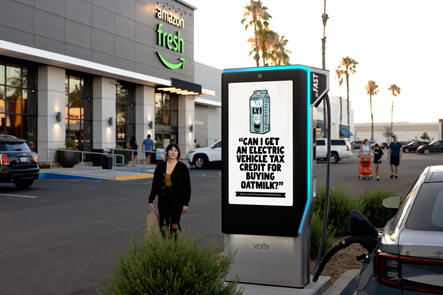
Volta's media-powered chargers also connect an advertiser's message to a more sustainable form of transportation, which is good news given the growing number of consumers who expect brands to be environmentally responsible. Volta's own research on the "Climate Conscious Consumer" reveals that "50% of the consumer general population have said that they're more interested in doing business with a company that commits to sustainability efforts." That sentiment is reflected in the incremental sales and ROAS delivered in Volta success stories, that is often "well above industry benchmarks."
Sharing their own benchmarking, which Ad Net Zero would appreciate, Silver said "the environmental impact of our campaigns to date have delivered approximately 150 million miles driven by electric vehicles." Their info-packed website even includes a "campaign calculator" for ad partners.
From Street to Store: A Success Story
For brands like Michelin that have leveraged Volta Media, that is especially good alignment. Silver offered up results from a recent campaign that showed an impressive 70% boost in awareness about proper tire use for EVs and a significant bump (38%) in positive perception of their environmentalism. (Michelin also connects the dots on their site with robust EV consumer information.)
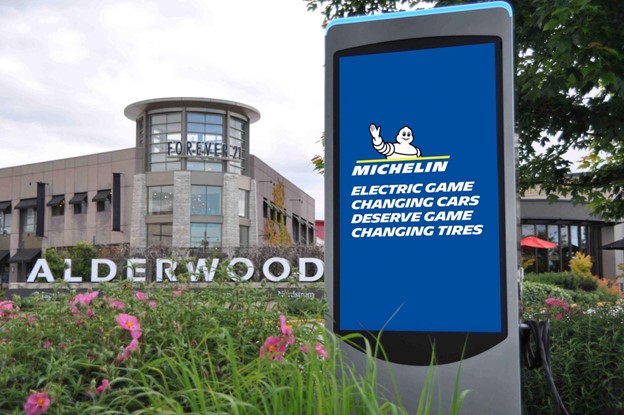
That ability to influence consumers right before purchase through messaging on EV chargers is then amplified with retail media.
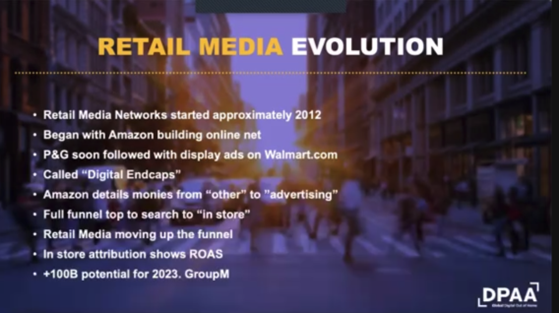
DPAA's Frey provided background on this area, historically referred to as "digital endcaps," and asked Kate Scott-Dawkins, who helms advertising industry forecasts and analyses for WPP's media investment group, to elaborate on retail media and the trends of other advertising vehicles. (Note: GroupM also announced a Coalition for Media Decarbonization last fall, adding fuel to the push for more sustainable advertising practices, and WPP is a member of Ad Net Zero.)
Rising Trends: The Emergence of Retail Media and the Reinvigoration of Out of Home
Acknowledging its trajectory, Scott-Dawkins said, "Retail media was something we broke out for the first time in December," for their impressive GroupM "This Year Next Year" biannual report which looks to the size and forecast of global advertising revenue. "It felt really important to start to look at that separately," she said, "because, I mean, it's 14% of overall global advertising this year going forward."
In recounting more report details she noted, "I don't think I'll ever see global advertising growth of nearly 25% again in my career, or the sort of whiplash effect of coming down off of that high, but [last year was] still pretty decent growth," referring to the 6.5% global advertising revenue growth in 2022 and projections for this year globally at 5.9%. She softened the blow of 2023's more modest growth when she said, "For the most part, what we've modeled up to this point has not been based on a case of deep global recession. We do think we're more on the soft landing side, even if it's going to stretch out a little bit longer than maybe we had originally thought."
In other specific examples of how ad dollars are shifting, the faster growing segments in the past couple of years are CTV, which has picked up some of the slack in linear TV especially among younger audiences. And "digital continues to grow, despite a lot of the headlines," Scott-Dawkins said. However, she added, "there will be vendors or ad sellers within that that are slower growing in certain areas, so I think it's important to look on a longer-term basis."
On the mind of all members on the call, she validated that "OOH recovered well ... and we'll be seeing more recovery in 2024." On a global level, though, "the most interesting recent story in Out of Home is certainly China: for the past six years leading up to 2022 they were the largest OOH market. But their lockdowns and zero-COVID policies in 2022 meant that we saw a 34% decline in China last year." Some growth there is expected in 2024, but not likely to regain their pre-pandemic levels within the next five years.
However, the December report says, OOH in some markets like Brazil, Australia, France and the U.S. are already above 2019 levels in 2022. In the U.S. specifically, it notes, "Further growth is likely to hinge on OOH providers' ability to digitize not just their inventory but also their operations and to align offerings with marketers that, we believe, are increasingly oriented nationally rather than locally."
OOH is also seen as a solution for many marketers being challenged by reach lacking in television-based campaigns. In the near term, the GroupM recommendation is "activating and measuring campaigns across not only linear and connected TV but also online video and OOH video inventory."
Certainly, the DPAA is bullish on digitization of out of home that has enabled targeting and dynamic ad serving, with the one-two punch of it being one of the few skipless and brand safe mediums. That is clearly a formula for another definition of "sustainable" advertising.
Click the social buttons to share this story with colleagues and friends.
The opinions expressed here are the author's views and do not necessarily represent the views of MediaVillage.com/MyersBizNet.


